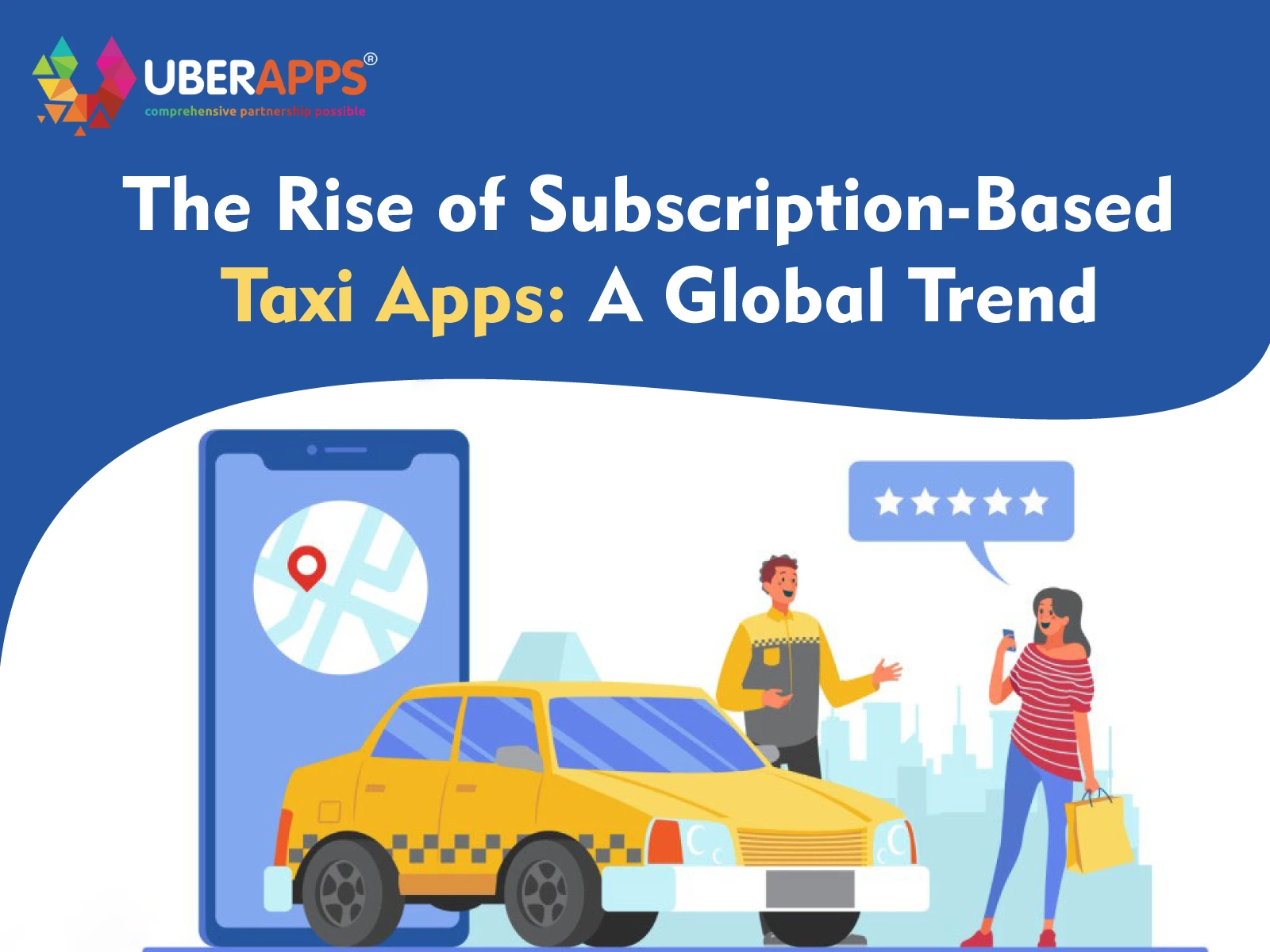
The Rise of Subscription-Based Taxi Apps: A Global Trend
In today’s on-demand economy, consumers value convenience, predictability, and affordability. The transportation industry is no exception. While traditional taxi booking models rely on pay-per-ride structures, subscription-based taxi apps are emerging as the next big trend in urban mobility.
With global adoption growing rapidly, platforms like UberApps are paving the way for businesses to introduce subscription-based services that benefit both customers and operators. From ride-hailing app features to in-app payments for taxi apps, SaaS-based taxi app development is enabling taxi companies to embrace this shift with ease.
Subscription-based taxi apps are rapidly becoming a global trend, offering predictable costs for riders and stable revenues for operators. Unlike traditional pay-per-ride models, subscriptions provide loyalty-driven benefits that align with today’s consumer behavior. Powered by SaaS-based taxi apps like UberApps, these platforms simplify subscription management, enable automated in-app payments, and deliver advanced ride-hailing app features. The trend is reinforced by global adoption across industries, rising urbanization, and changing demographics favoring convenience and affordability.For operators, the benefits include steady income, optimized fleet utilization, and stronger customer retention. For passengers, it’s all about transparency, affordability, and reliability. With technologies like AI, IoT, and blockchain enhancing the experience, subscription taxi apps represent the future of mobility. Businesses that adapt early with solutions like UberApps will not only stay competitive but also lead the transformation of the taxi booking industry worldwide.
Why Subscription-Based Taxi Apps Are Gaining Popularity
1 Changing Consumer Preferences
Today’s riders want predictable monthly expenses instead of fluctuating ride fares. Subscription models deliver:
- Unlimited or fixed rides per month
- Discounts for loyal users
- Enhanced customer retention
Key takeaway: Subscription-based taxi services create stickiness, encouraging passengers to stay within one app ecosystem.
1 Global Adoption Across Industries
The subscription economy has already transformed industries like music (Spotify), video streaming (Netflix), and retail (Amazon Prime). The taxi booking apps industry is now following suit, with SaaS platforms enabling mobility businesses to adopt similar models.
What Are Subscription-Based Taxi Apps?
A subscription-based taxi app allows passengers to pay a recurring monthly or weekly fee for access to discounted or unlimited rides. Instead of unpredictable fares, customers enjoy transparent pricing, while operators benefit from steady recurring revenue.
Benefits for Riders
- Predictable monthly transportation costs
- No surge pricing surprises
- Exclusive ride perks
Benefits for Operators
- Improved customer loyalty
- Steady cash flow
- Easier financial planning
Bold takeaway: Subscription-based taxi apps benefit both sides of the marketplace, creating win-win scenarios for riders and operators alike.
SaaS-Based Taxi App Development for Subscription Models
The rise of subscription services would not have been possible without SaaS-based taxi apps. Cloud-powered platforms like UberApps make it easy for entrepreneurs to launch subscription-enabled taxi businesses without building custom solutions from scratch.
Key Advantages of SaaS Taxi Platforms
- Faster go-to-market: Pre-built templates with subscription modules.
- Lower development costs: Pay-as-you-go instead of high upfront investments.
- Scalability: Manage subscriptions across multiple cities with centralized dashboards.
Essential Ride-Hailing App Features in Subscription Apps
- User subscription management (upgrade, cancel, pause)
- Automated recurring in-app payments for taxi apps
- Notifications for subscription renewals and billing
- Personalized offers for loyal riders
Global Trends Driving Subscription Taxi Models
Urbanization and Mobility-as-a-Service (MaaS)
Growing urban populations are pushing cities toward Mobility-as-a-Service, where subscriptions integrate taxis with other public and private mobility solutions.
Younger Demographics Prefer Subscriptions
Millennials and Gen Z are less interested in car ownership and more comfortable with subscription services. Taxi businesses are capitalizing on this shift.
Pandemic-Induced Behavior Change
COVID-19 accelerated adoption of predictable, safe, and affordable transport. Subscriptions offer regular riders peace of mind at consistent pricing.
In-App Payments for Subscription Taxi Apps
Secure and Automated Billing
SaaS platforms integrate with global payment gateways like Stripe, PayPal, and Razorpay to handle subscription billing seamlessly.
Multiple Payment Methods
- Credit/debit cards
- Digital wallets
- Bank transfers
- Localized regional payment options
Key takeaway: Automated in-app payments for taxi apps eliminate manual billing headaches and provide customers with frictionless experiences.
How Taxi Businesses Benefit from Subscription Models
Steady Revenue Streams
Unlike unpredictable per-ride earnings, subscription-based taxi apps provide stable, recurring monthly income.
Lower Customer Acquisition Costs
Loyal subscribers reduce the need for continuous marketing spend.
Improved Driver Utilization
More predictable ride requests lead to better planning and optimized driver schedules.
Competitive Differentiation
Taxi companies can stand out from global giants like Uber and Lyft by offering affordable subscription packages tailored to local riders.
Challenges of Subscription-Based Taxi Apps
Balancing Profitability
Businesses must carefully balance subscription pricing to remain profitable while delivering value to riders.
Regional Regulatory Differences
Subscription plans may need adjustments to comply with local transportation laws.
Market Education
Riders in some regions are still new to subscription models, requiring awareness campaigns.
Real-World Examples of Subscription Taxi Models
Uber Pass and Lyft Pink
Global leaders like Uber and Lyft already offer subscription plans that include discounted rides, free delivery, and priority service.
Local Startups Using SaaS Taxi Solutions
Regional taxi operators are turning to platforms like UberApps to launch subscription-based services tailored to their city or country.
The Future of Subscription-Based Taxi Apps
AI-Powered Personalization
SaaS platforms will use AI to recommend subscription plans based on riding frequency, routes, and spending behavior.
IoT and Connected Vehicles
Real-time vehicle tracking will allow operators to optimize fleets for subscription users, ensuring fast pickups.
Blockchain for Transparent Billing
Blockchain technology will ensure tamper-proof ride records and transparent subscription billing across multiple regions.
Key takeaway: Subscription-based taxi apps will evolve into smarter, safer, and more scalable platforms with the help of emerging technologies.
Steps to Launch a Subscription-Based Taxi Business
- Choose a SaaS taxi app provider like UberApps.
- Define your subscription plans (weekly, monthly, premium).
- Integrate secure in-app payments for recurring billing.
- Onboard drivers and vehicles to support predictable demand.
- Launch marketing campaigns to educate and attract riders.
- Monitor performance with analytics and optimize plans over time.
Conclusion
The rise of subscription-based taxi apps marks a fundamental shift in the way people use urban mobility. Instead of unpredictable fares and sporadic usage, passengers are embracing the comfort of predictable monthly costs and exclusive perks. For taxi businesses, this model ensures loyalty, steady revenue, and long-term sustainability.
SaaS platforms like UberApps are at the heart of this global trend. By offering ready-to-launch solutions with features such as subscription management, in-app payments, real-time analytics, and scalable architecture, SaaS empowers both startups and established operators to transition smoothly into subscription-driven mobility.
The subscription model aligns with broader consumer behavior shifts seen across industries, proving it is more than just a passing trend—it’s the future of mobility. Taxi businesses that adapt early will thrive in this evolving market, while those that resist risk being left behind.
Bold takeaway: Subscription-based taxi apps are no longer optional—they are the future of taxi app development worldwide.
FAQS
1. What is a subscription-based taxi app?
It’s a taxi booking app that allows passengers to pay a recurring fee (weekly/monthly) for discounted or unlimited rides instead of per-trip charges.
2. How do SaaS platforms support subscription taxi models?
They provide pre-built features such as subscription management, automated billing, secure payment gateways, and analytics for easy scalability.
3. Are subscription-based taxi apps profitable for businesses?
Yes. They ensure steady recurring revenue, reduce marketing costs, and improve customer loyalty when priced correctly.
4. Can passengers cancel or change their subscriptions?
Most SaaS-based taxi apps offer flexible subscription management, allowing users to pause, upgrade, or cancel plans anytime.
5. Are subscription taxi models suitable for small operators?
Absolutely. Even small taxi businesses can benefit from predictable revenue streams and customer retention using SaaS-powered subscription apps.
Author's Bio

Vinay Jain is the Founder of UBERApps and brings over 10 years of entrepreneurial experience. His focus revolves around software & business development and customer satisfaction.

